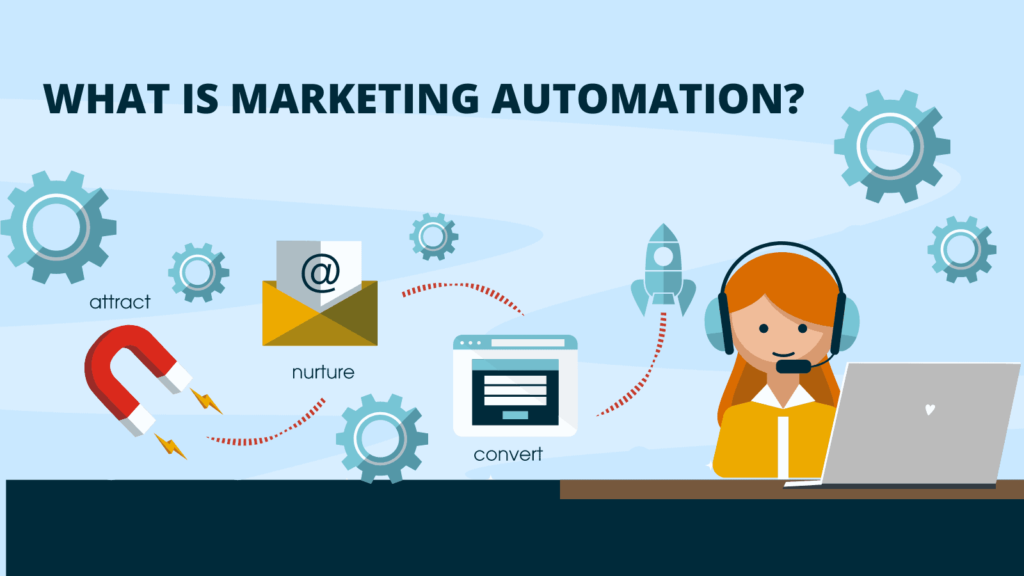Marketing automation is streamlining and automating repetitive marketing jobs, processes, and workflows using software and technology. Businesses of all sizes can take advantage of its many advantages, which include increased productivity, better customer satisfaction, and improved results.
Marketing automation software typically offers a range of features that enable businesses to automate repetitive marketing activities, such as email marketing, social media posting, lead nurturing, lead scoring, customer segmentation, campaign management, and analytics. These tools allow marketers to create, schedule, and deliver personalized and targeted content to their audience at scale.
CRM systems and marketing automation platforms frequently work together to track and manage customer interactions and data throughout the whole customer lifecycle. Marketers may make data-driven decisions and maximize their marketing efforts by employing data and analytics to get insights into customer behavior, preferences, and engagement.
Some common functionalities of marketing automation include:
Email Marketing Automation
Lead Nurturing and Scoring
Social Media Automation
Landing Page and Form Automation
Workflow and Campaign Automation
Analytics and Reporting
Here are some key benefits of marketing automation:
1. Time and Resource Savings:
Marketing automation frees up significant time and resources by automating tedious and time-consuming operations like email campaigns, social media posting, lead nurturing, and data analysis. This enables marketers to concentrate on high-value tasks like developing strategies, producing content, and developing client relationships.
2. Improved Lead Management:
Businesses can efficiently handle leads throughout the customer journey thanks to marketing automation. It assists in gathering leads from multiple sources, nurturing them with individualized content, and monitoring their behavior to find prospects who are ready to make a purchase. Automation ensures that the correct messages are sent to the right people at the right time through lead scoring and segmentation capabilities.
3. Enhanced Personalization:
Marketers can send highly specialized and individualized information to their audience thanks to automation. Businesses can develop dynamic campaigns that respond to customer choices, behaviors, and demographics by utilizing data and analytics. Personalization fosters more profound relationships with customers, boosts engagement, and promotes conversions.
4. Increased Efficiency and Consistency:
Automation ensures consistency in messaging and branding across different marketing channels. It eliminates human errors and enables marketers to create standardized workflows and templates for campaigns, ensuring a cohesive and professional image for the brand. Additionally, automation streamlines collaboration and communication between marketing teams, improving overall efficiency.
5. Effective Customer Relationship Management:
Businesses may maintain and improve customer relationships at scale by using marketing automation. From onboarding and post-purchase nurturing to loyalty programs and re-engagement initiatives, it provides personalized communication throughout the client lifecycle. Automation increases customer satisfaction and retention rates by sending pertinent and timely communications.
Implementing marketing automation in your strategy involves the following steps:
1. Set Clear Objectives:
Establish your marketing goals and pinpoint the areas where automation can assist in achieving them. Clearly identify the results you are looking for, whether they are for lead generation, lead nurturing, customer retention, or other marketing efforts.
2. Select the Right Automation Tools:
Research and choose a marketing automation platform that aligns with your business needs. Consider factors like scalability, ease of use, integration capabilities with existing systems, and the specific features required to support your strategy.
3. Define Workflows and Segmentation:
Map out your customer journey and create workflows that automate tasks and interactions at various touchpoints. Segment your audience based on relevant criteria such as demographics, behavior, and purchase history to deliver targeted content.
4. Create Engaging Content:
Develop compelling content that aligns with your target audience’s needs and preferences. Leverage the automation platform to personalize and schedule content delivery across channels, ensuring consistent messaging and optimized engagement.
5. Monitor and Analyze Performance:
Track and evaluate important indicators frequently to gauge the success of your automation initiatives. Analytical insights should be used to pinpoint problem areas, make data-driven improvements, and optimize your marketing.
6. Test and Iterate:
Continuously test different elements of your automation strategy, such as subject lines, CTAs, and timing. Use A/B testing to refine your campaigns and improve performance over time.
To maximize its advantages and effects on your marketing strategy, keep in mind that marketing automation is not a one-time setup but rather an ongoing activity that necessitates monitoring, adjusting, and optimization.
To learn more about Marketing Skills follow CrazyWebDev Technologies!
Reference Image – https://rocketcrm.co.uk/what-is-marketing-automation-and-how-could-it-help-grow-your-business/
